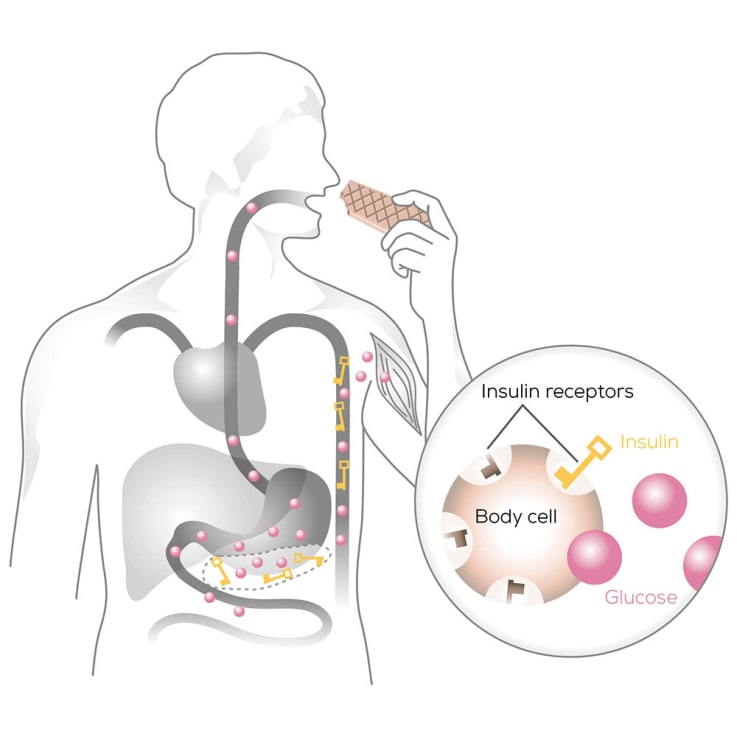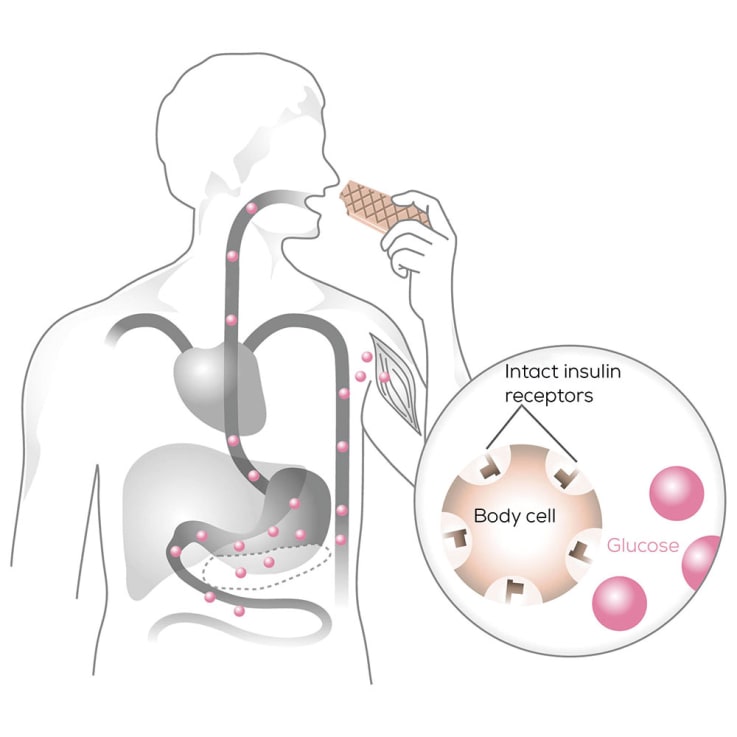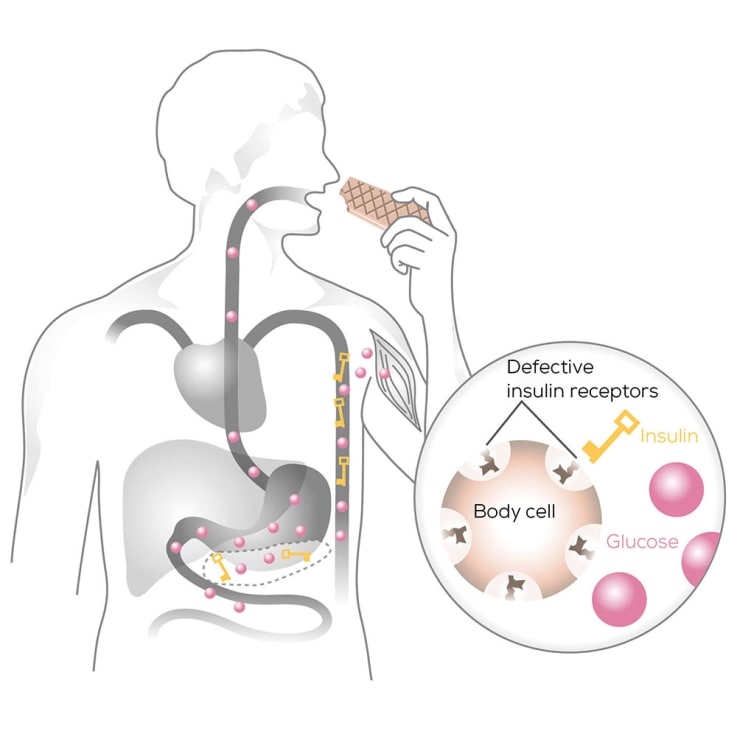Glucometer
13 ArticlesTo top
Diabetes, also known as diabetes mellitus, is a chronic metabolic disease in which the body has problems regulating blood glucose levels. A healthy person's blood glucose level is controlled by the hormone insulin, which is produced by the pancreas. In diabetes, insulin production is either impaired, which is the result of type 1 diabetes, or the body cells do not respond adequately to insulin. This means that the insulin cannot take effect; this is type 2 diabetes.
What is diabetes?
Diabetes, also known as diabetes mellitus, is a chronic metabolic disease in which the body has problems regulating blood glucose levels. A healthy person's blood glucose level is controlled by the hormone insulin, which is produced by the pancreas. In diabetes, insulin production is either impaired, which is the result of type 1 diabetes, or the body cells do not respond adequately to insulin. This means that the insulin cannot take effect; this is type 2 diabetes.
What role does insulin play in the human body?
We need energy for the body to function. It is absorbed from food, broken down into its constituent parts, transported to all the cells of the body and converted into energy. Glucose is especially important here. It is the smallest sugar component that enters the body's cells via the blood.
Once glucose reaches the body cells, it requires insulin, which is produced in the pancreas. Insulin has a key function: it opens the body's cells to take up glucose, which can then be used in the cells. This process can be thought of as a "key-lock" principle. In the "key-lock" principle, insulin (the key) opens the cells (the lock) so that the glucose can enter the cells from the blood.

What role does insulin play in the human body?
We need energy for the body to function. It is absorbed from food, broken down into its constituent parts, transported to all the cells of the body and converted into energy. Glucose is especially important here. It is the smallest sugar component that enters the body's cells via the blood.
Once glucose reaches the body cells, it requires insulin, which is produced in the pancreas. Insulin has a key function: it opens the body's cells to take up glucose, which can then be used in the cells. This process can be thought of as a "key-lock" principle. In the "key-lock" principle, insulin (the key) opens the cells (the lock) so that the glucose can enter the cells from the blood.

What happens in the body of a person with diabetes?
In people with diabetes, this cycle does not function properly, as either too little insulin is produced or none at all, and certain cells can also be insulin resistant. As a result of this is, the glucose continues to circulate in the bloodstream and the blood glucose content rises above normal levels. Diabetes is recognised by a fasting glucose level above 110 mg/dL (or 6.1 mmol/L).
What happens in the body of a person with diabetes?
In people with diabetes, this cycle does not function properly, as either too little insulin is produced or none at all, and certain cells can also be insulin resistant. As a result of this is, the glucose continues to circulate in the bloodstream and the blood glucose content rises above normal levels. Diabetes is recognised by a fasting glucose level above 110 mg/dL (or 6.1 mmol/L).
There are various forms of diabetes. The two most frequent forms are type 1 diabetes, which is mainly diagnosed at a younger age (<40 years old) and type 2 diabetes, which was previously known as adult-onset diabetes; today around 90-95% of all diabetic patients have developed this form.
What types of diabetes are there?
There are various forms of diabetes. The two most frequent forms are type 1 diabetes, which is mainly diagnosed at a younger age (<40 years old) and type 2 diabetes, which was previously known as adult-onset diabetes; today around 90-95% of all diabetic patients have developed this form.
Type 1 diabetes
In type 1 diabetes, the body no longer produces its own insulin. The body's own immune system destroys the beta cells in the pancreas, the organ in charge of insulin production. Over time, this destruction results in insulin deficiency. Type 1 diabetes only fully develops once approximately 80-90% of the beta cells have been destroyed. This reaction often sets in during childhood or adolescence. Insulin therapy is essential to life in this case. Experts believe that factors relating to both genes and viruses play a role here.
The "key-lock" principle is violated. No insulin (the key) is produced. The body cells (the lock) are not opened to absorb glucose.

Type 1 diabetes
In type 1 diabetes, the body no longer produces its own insulin. The body's own immune system destroys the beta cells in the pancreas, the organ in charge of insulin production. Over time, this destruction results in insulin deficiency. Type 1 diabetes only fully develops once approximately 80-90% of the beta cells have been destroyed. This reaction often sets in during childhood or adolescence. Insulin therapy is essential to life in this case. Experts believe that factors relating to both genes and viruses play a role here.
The "key-lock" principle is violated. No insulin (the key) is produced. The body cells (the lock) are not opened to absorb glucose.

Type 2 diabetes
Type 2 is the most common form of diabetes. The number of people with type 2 diabetes is rising by around 5% every year in Germany, and it is increasingly diagnosed in childhood and adolescence (Hauner, 2007).
As well as insulin resistance, insulin release is often also impaired in type 2 diabetes. Body cells become increasingly insensitive to insulin over time, which means that less and less glucose can be absorbed from the blood. The beta cells in the pancreas try to compensate for the cell's reduced uptake by increasing insulin production, but it does not prevent an increase in the blood sugar level. This increased production by the beta cells leads to their exhaustion in the long term.
Environmental and, above all, behavioural factors are critical for developing type 2 diabetes. The most significant factor is being overweight. The risk of being affected by diabetes increases with body weight. Other important factors are poor diet and not exercising enough as well as genetic predisposition.
The "key-lock" principle is violated. The "key" insulin is produced, but no longer fits into the "lock," as the cells no longer react correctly to the insulin.

Type 2 diabetes
Type 2 is the most common form of diabetes. The number of people with type 2 diabetes is rising by around 5% every year in Germany, and it is increasingly diagnosed in childhood and adolescence (Hauner, 2007).
As well as insulin resistance, insulin release is often also impaired in type 2 diabetes. Body cells become increasingly insensitive to insulin over time, which means that less and less glucose can be absorbed from the blood. The beta cells in the pancreas try to compensate for the cell's reduced uptake by increasing insulin production, but it does not prevent an increase in the blood sugar level. This increased production by the beta cells leads to their exhaustion in the long term.
Environmental and, above all, behavioural factors are critical for developing type 2 diabetes. The most significant factor is being overweight. The risk of being affected by diabetes increases with body weight. Other important factors are poor diet and not exercising enough as well as genetic predisposition.
The "key-lock" principle is violated. The "key" insulin is produced, but no longer fits into the "lock," as the cells no longer react correctly to the insulin.

Type 1 diabetes:
The initial symptoms usually appear suddenly:
- Intense and sudden thirst
- Increased urge to urinate
- Vomiting and muscle cramps
Reduced performance and significant weight loss are often factors as well. There are also symptoms such as fatigue and disorders of vision and concentration.
Type 2 diabetes:
In the early stage of type 2 diabetes, most patients do not have any symptoms, or those that they do have are non-specific. The diagnosis is often made through incidental findings in a routine examination.
Symptoms include:
- Frequent fatigue
- Poor general condition
- Increased susceptibility to infection
Increased thirst and urge to urinate only appear in rare cases. Rapid weight loss does not occur; instead, hunger tends to increase and with it the associated weight gain. Since environmental and behavioural factors also play an important role in developing type 2 diabetes, the treatment of type 2 diabetes can be significantly supported through targeted measures in the patient's daily life.
Recognising symptoms of both types of diabetes
How can I recognise diabetes?
Type 1 diabetes:
The initial symptoms usually appear suddenly:
- Intense and sudden thirst
- Increased urge to urinate
- Vomiting and muscle cramps
Reduced performance and significant weight loss are often factors as well. There are also symptoms such as fatigue and disorders of vision and concentration.
Type 2 diabetes:
In the early stage of type 2 diabetes, most patients do not have any symptoms, or those that they do have are non-specific. The diagnosis is often made through incidental findings in a routine examination.
Symptoms include:
- Frequent fatigue
- Poor general condition
- Increased susceptibility to infection
Increased thirst and urge to urinate only appear in rare cases. Rapid weight loss does not occur; instead, hunger tends to increase and with it the associated weight gain. Since environmental and behavioural factors also play an important role in developing type 2 diabetes, the treatment of type 2 diabetes can be significantly supported through targeted measures in the patient's daily life.
Our Beurer blood glucose monitors are compact, easy to use and can measure your blood glucose quickly and effectively. These monitors are an essential component of diabetes treatment. They help you detect high blood glucose levels or hypoglycaemia and to avoid them in the long term with the help of your accompanying medical treatment.
Our blood glucose monitors are equipped with a blood volume check for added certainty. This means that the measurement is only carried out if there is a sufficient amount of blood. In addition to our devices for determining blood glucose, we also offer suitable accessories such as lancets, control solutions and test strips.
With a glucometer from Beurer, you can optimise your diabetes management and make sure that you can reliably detect hyperglycaemia or hypoglycaemia.
Beurer blood glucose monitors
Our Beurer blood glucose monitors are compact, easy to use and can measure your blood glucose quickly and effectively. These monitors are an essential component of diabetes treatment. They help you detect high blood glucose levels or hypoglycaemia and to avoid them in the long term with the help of your accompanying medical treatment.
Our blood glucose monitors are equipped with a blood volume check for added certainty. This means that the measurement is only carried out if there is a sufficient amount of blood. In addition to our devices for determining blood glucose, we also offer suitable accessories such as lancets, control solutions and test strips.
With a glucometer from Beurer, you can optimise your diabetes management and make sure that you can reliably detect hyperglycaemia or hypoglycaemia.


